|
 |
Pieter de Kempener
|
|
Pedro Campana (1503-1586) was a Flemish painter of the Renaissance period, mainly active in Italy and Spain. His actual name was Pieter de Kempeneer, translated into French as Champaigne, and was also known as Peter Van de Velde.
Born in Brussels, he trained there with Bernard Van Orley. His early life appears to have been spent in Italy, where he carefully studied the paintings of Raphael, and declared himself as his pupil. In 1530 he was at work at some scene-painting, representing a triumphal arch to be erected on the occasion of the coronation of Charles V, Holy Roman Emperor in Bologna, and he then left for Spain, on the advice, it is said, of Cardinal Domenico Grimani, and spent the rest of his life in that country, only returning to Brussels about 1563 or 1565.
Between 1537 and 1562 he was associated with Luis de Vargas and the Italian sculptor Torregiano in establishing a school of painting in Seville, which eventually became the academy of the place; amongst the pupils educated in it was Morales. He painted for the monastery of St. Mary of Grace, Church of Santa Cruz, in the city, an altar-piece representing the Descent from the Cross (1548), which is now in the cathedral, having been removed there when the church fell into ruins. There are other works by the same painter in Seville Cathedral, especially two representing the Purification of the Virgin and the Resurrection; and the various churches of the city, S. Isidoro, S. Pedro, S. Catalina, and S. Juan, all possess paintings by this artist. One of his last works was the restoration and repainting of a chapel belonging to Hernando de Jaen, an important resident of Seville. Murillo requested that he be buried near Campana's picture, and his burial took place in the Church of Santa Cruz, close underneath the Descent from the Cross, but the whole building was burned to the ground during the Napoleonic Wars, and the tomb perished. |
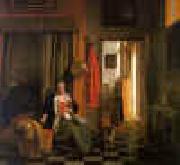 |
Pieter de Hooch
|
|
1629-1684
Dutch
Pieter de Hooch Galleries
De Hooch was born in Rotterdam to Hendrick Hendricksz de Hooch, a bricklayer, and Annetge Pieters, a midwife. He was the eldest of five children and outlived all of his siblings. He studied art in Haarlem under the landscape painter, Nicolaes Berchem. Beginning in 1650, he worked as a painter and servant for a linen-merchant and art collector named Justus de la Grange. His service for the merchant required him to accompany him on his travels to The Hague, Leiden, and Delft, to which he eventually moved. It is likely that de Hooch handed over most of his works to la Grange during this period in exchange for board and other benefits, as this was a common commercial arrangement for painters at the time, and a later inventory recorded that la Grange possessed eleven of his paintings.
De Hooch was married in Delft in 1654 to Jannetje van der Burch, by whom he fathered seven children. While in Delft, de Hooch is also believed to have learned from the painters Carel Fabritius and Nicolaes Maes, who were both early members of the Delft School. He became a member of the painters' guild of Saint Luke in 1655, and had moved to Amsterdam by 1661.
The early work of de Hooch, like most young painters of his time, was mostly composed of scenes of soldiers in stables and taverns, though he used these to develop great skill in light, color, and perspective rather than to explore an interest in the subject matter. After beginning his family in the mid-1650s, he switched his focus to domestic scenes and family portraits. His work showed astute observation of the mundane details of everyday life while also functioning as well-ordered morality tales. These paintings often exhibited a sophisticated and delicate treatment of light similar to those of Vermeer, who lived in Delft at the same time as de Hooch. 19th century art historians had assumed that Vermeer had been influenced by de Hooch's work, but the opposite is now believed.
|
 |
Pieter de Grebber
|
|
(c. 1600, Haarlem - 1652/3, Haarlem) was a Dutch Golden Age painter.
De Grebber was the oldest son of Frans Pietersz de Grebber (1573 - 1643), a painter and embroiderer in Haarlem, and the brother of the painters Maria and Albert. He learned to paint from his father and from Hendrick Goltzius. He was descended from a Catholic and artistic family and his sister Maria later became the mother-in-law of Gabriel Metsu. He was a friend of the priest and musicologist Jan Albertszoon Ban, and had a poem set to music by the Haarlem composer Cornelis Padbrue. In 1632 he became a member of the Haarlem Guild of St. Luke, but he had already been active as a painter for 10 years. His pupils were Gerbrand Ban, Nicolaes Pietersz Berchem, Egbert van Heemskerck, and Dirck Helmbreeker.
In 1618, father and son went to Antwerp and negotiated with Peter Paul Rubens over the sale of his painting "Daniel in the lions pit". It was then handed - via the English ambassador in the Republic, Sir Dudley Carleton - to king Charles I. Pieter got important commissions not only in Haarlem, but also from the stadholder Frederik Hendrik. As such, he worked on the decoration of the Huis Honselaarsdijk in Naaldwijk and at the Paleis Noordeinde in Huis ten Bosch in the Hague. He painted altar pieces for churches in Flanders and hidden Catholic churches in the Republic. He may also have worked for Danish clients.
Pieter remained single and lived from 1634 until his death at the Haarlem Beguinage.
|
 |
Pieter de Grebber
|
|
1600-1653
Dutch
Pieter de Grebber Gallery
Grebber was the son of Frans Pietersz de Grebber (1573?C1643), a painter and embroiderer in Haarlem, and would have been taught painting by his father and by Hendrick Goltzius. He was descended from a Catholic and artistic family (2 of his brothers, and his sister Maria, the mother-in-law of Gabriel Metsu, were known as painters). He was friendly with the priest and musicologist Jan Albertszoon Ban, and had a poem set to music by the Haarlem composer Cornelis Padbru??.
In 1618, father and son went to Antwerp and negotiated with Peter Paul Rubens over the sale of his painting "Daniel in the lions pit". It was then handed - via the English ambassador in the Republic, Sir Dudley Carleton - to king Charles I. Pieter got important commissions not only in Haarlem, but also from the stadholder Frederik Hendrik. As such, he worked with on the decoration of the Huis Honselaarsdijk in Naaldwijk and at the Paleis Noordeinde in Huis ten Bosch in the Hague. He painted altar pieces for churches in Flanders and hidden Catholic churches in the Republic. He may also have worked for Danish clients.
|
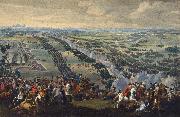 |
Pierre-Denis Martin
|
|
(b. ca. Paris 1663-d. Paris 1742) was a French painter, best known for his paintings of royal residences.
He was also known as "Martin le Jeune" ("Martin the Young") or as "Martin des Gobelins" (because he was employed at the Gobelins Manufactory).
|
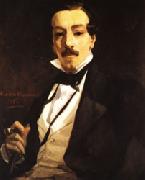 |
Pierre Puvis de Chavannes
|
|
1824-1898
French
Pierre Puvis de Chavannes Art Galleries
Born in Lyons on Dec. 14, 1824, Pierre Puvis de Chavannes belonged to the generation of Gustave Courbet and ??douard Manet, and he was fully aware of their revolutionary achievements. Nevertheless, he was drawn to a more traditional and conservative style. From his first involvement with art, which began after a trip to Italy and which interrupted his intention to follow the engineering profession that his father practiced, Puvis pursued his career within the scope of academic classicism and the Salon. Even in this chosen arena, however, he was rejected, particularly during the 1850s. But he gradually won acceptance. By the 1880s he was an established figure in the Salons, and by the 1890s he was their acknowledged master.
In both personal and artistic ways Puvis career was closely linked with the avant-grade. In the years of his growing public recognition, when he began to serve on Salon juries, he was consistently sympathetic to the work of younger, more radical artists. Later, as president of the Societe Nationale des Beaux-Arts - the new Salon, as it was called - he was able to exert even more of a liberalizing influence on the important annual exhibitions.
Puvis sympathy to new and radical artistic directions was reflected in his own painting. Superficially he was a classicist, but his personal interpretation of that style was unconventional. His subject matter - religious themes, allegories, mythologies, and historical events - was clearly in keeping with the academic tradition. But his style eclipsed his outdated subjects: he characteristically worked with broad, simple compositions, and he resisted the dry photographic realism which had begun to typify academic painting about the end of the century. In addition, the space and figures in his paintings inclined toward flatness, calling attention to the surface on which the images were depicted. These qualities gave his work a modern, abstract look and distinguished it from the sterile tradition to which it might otherwise have been linked.
Along with their modern, formal properties, Puvis paintings exhibited a serene and poetic range of feeling. His figures frequently seem to be wrapped in an aura of ritualistic mystery, as though they belong in a private world of dreams or visions. Yet these feelings invariably seem fresh and sincere. This combination of form and feeling deeply appealed to certain avant-garde artists of the 1880s and 1890s. Although Puvis claimed he was neither radical nor revolutionary, he was admired by the symbolist poets, writers, and painters - including Paul Gauguin and Maurice Denis - and he influenced the neoimpressionist painter Georges Seurat.
During his mature career Puvis executed many mural paintings. In Paris he did the Life of St. Genevieve (1874-1878) in the Panth??on and Science, Art, and Letters (1880s) in the Sorbonne. In Lyons he executed the Sacred Grove, the Antique Vision, and Christian Inspiration (1880s) in the Mus??e des Beaux-Arts. He painted Pastoral Poetry (1895-1898) in the Boston Public Library. These commissions reflect the high esteem with which Puvis was regarded during his own lifetime. Among his most celebrated oil paintings are Hope (1872) and the Poor Fisherman (1881). He died in Paris on Oct. 10, 1898. |
 |
Piero di Cosimo
|
|
1462-1521
Italian Piero di Cosimo Galleries
Italian painter and draughtsman.
Tax declarations made by Piero di Cosimo's father suggest that the artist was born in either 1461 or 1462. According to the first, he was eight years old in 1469, while a catasto (land registry declaration) of 1480 gives his age as 18. A document of 1457 establishes that his father, Lorenzo di Piero d'Antonio, was a maker of small tools (succhiellinaio) rather than a goldsmith, as Vasari claimed. By 1480 Piero appears no longer to have been living at the family house in the Via della Scala, Florence, but was an unsalaried apprentice or workshop assistant to Cosimo Rosselli, from whom he received room and board and eventually took the name of Piero di Cosimo. |
 |
Piero della Francesca
|
|
Italian Early Renaissance Painter, ca.1422-1492 Italian painter and theorist. His work is the embodiment of rational, calm, monumental painting in the Italian Early Renaissance, an age in which art and science were indissolubly linked through the writings of Leon Battista Alberti. Born two generations before Leonardo da Vinci, Piero was similarly interested in the scientific application of the recently discovered rules of perspective to narrative or devotional painting, especially in fresco, of which he was an imaginative master; and although he was less universally creative than Leonardo and worked in an earlier idiom, he was equally keen to experiment with painting technique. Piero was as adept at resolving problems in Euclid, whose modern rediscovery is largely due to him, as he was at creating serene, memorable figures, whose gestures are as telling and spare as those in the frescoes of Giotto or Masaccio. His tactile, gravely convincing figures are also indebted to the sculpture of Donatello, an equally attentive observer of Classical antiquity. In his best works, such as the frescoes in the Bacci Chapel in S Francesco, Arezzo, there is an ideal balance between his serene, classical compositions and the figures that inhabit them, the whole depicted in a distinctive and economical language. In his autograph works Piero was a perfectionist, creating precise, logical and light-filled images (although analysis of their perspective schemes shows that these were always subordinated to narrative effect). However, he often delegated important passages of works (e.g. the Arezzo frescoes) to an ordinary, even incompetent, assistant. |
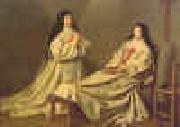 |
Philippe de Champaigne
|
|
1602-1674
Philippe de Champaigne Locations
His artistic style was varied: far from being limited to the realism traditionally associated with Flemish painters, it developed from late Mannerism to the powerful lyricism of the Baroque. It was influenced as much by Rubens as by Vouet, culminating in an aesthetic vision of the world and of humanity that was based on an analytic view of appearances and on psychological truth. He was perhaps the greatest portrait painter of 17th-century France. At the same time he was one of the principal instigators of the Classical tendency and a founder-member of the Acadmie Royale de Peinture et de Sculpture. His growing commitment to the Jansenist religious movement (see JANSENISM) and the severe plainness of the works that it inspired has led to his being sometimes considered to typify Jansenist thinking, with its iconoclastic impulse, in spite of the opposing evidence of his other paintings. He should be seen as an example of the successful integration of foreign elements into French culture and as the representative of the most intellectual current of French painting. |
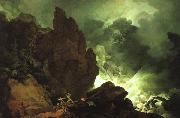 |
Philip James de Loutherbourg
|
|
1740-1812
French (Resident in UK)
Philip James de Loutherbourg Gallery
Philip James de Loutherbourg, also seen as Philippe-Jacques and Philipp Jakob and with the appellation the Younger (31 October 1740 ?C 11 March 1812) was an English artist of French origin.
He was born in Strasbourg, where his father, the representative of a Polish family, practised miniature painting; but he spent the greater part of his life in London, where he was naturalized, and exerted a considerable influence on the scenery of the English stage, as well as on the artists of the following generation. De Loutherbourg was intended for the Lutheran ministry, and was educated at the University of Strasbourg.
As the calling, however, was foreign to his nature, he insisted on being a painter, and placed himself under Charles-Andr?? van Loo in Paris. The result was an immediate and precocious development of his powers, and he became a figure in the fashionable society of that day. In 1767 he was elected into the French Academy below the age required by the law of the institution, and painted landscapes, sea storms, battles, all of which had a celebrity above those of the specialists then working in Paris. His debut was made by the exhibition of twelve pictures, including Storm at Sunset, Night, Morning after Rain.
He is next found travelling in Switzerland, Germany and Italy, distinguishing himself as much by mechanical inventions as by painting. One of these, showing quite new effects produced in a model theatre, was the wonder of the day. The exhibition of lights behind canvas representing the moon and stars, the illusory appearance of running water produced by clear blue sheets of metal and gauze, with loose threads of silver, and so on, were his devices. In 1771 he came to London, and was employed by David Garrick, who offered him £500 a year to apply his inventions to Drury Lane, and to superintend the scene-painting, which he did with complete success, making a new era in the adjuncts of the stage. Garrick's own piece, the Christmas Tale, and the pantomime, 1781-1782, introduced the novelties to the public, and the delight not only of the masses, but of Reynolds and the artists, was unbounded. The green trees gradually became russet, the moon rose and lit the edges of passing clouds, and all the world was captivated by effects we now take little notice of. A still greater triumph awaited him on his opening an entertainment called the Eidophusikon, which showed the rise, progress and result of a storm at sea that which destroyed the great Indiaman, the Halsewell,and the Fallen Angels raising the Palace of Pandemonium. De Loutherbourg has been called the inventor of the panorama, but this honor does not belong to him, although it first appeared about the same time as the eidophusicon. The first panorama was painted and exhibited by Scottish painter Robert Barker. |
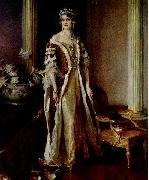 |
Philip Alexius de Laszlo
|
|
Philip Alexius de Laszlo, MVO (30 April 1869 Budapest - 22 November 1937 London) was a Hungarian painter known particularly for his portraits of royal and aristocratic personages.
Laszlo was born in Budapest as Laub Fulop Elek (Hungarian style with the surname first), the eldest son of a Jewish tailor. The family changed its name to Laszlo in 1891.
As a young man, Laszlo apprenticed to a photographer while studying art, eventually earning a place at the National Academy of Art, where he studied under Bertalan Szekely and Karoly Lotz. He followed this with studies in Munich and Paris. Laszlo's portrait of Pope Leo XIII earned him a Grand Gold Medal at the Paris International Exhibition in 1900.
In 1903 Laszlo moved from Budapest to Vienna. In 1907 he moved to England. He remained based in London for the rest of his life while traveling the world to fulfill commissions.
Laszlo's patrons awarded him numerous honors and medals. In 1909 he was named an honorary Member of the Royal Victorian Order by King Edward VII of the United Kingdom. In 1912 he was ennobled by King Franz Joseph of Hungary; his surname became "Laszlo de Lombos". The family later shortened the name to "de Laszlo".
Laszlo became a British citizen in 1914 but was interned for over twelve months in 1917 and 1918 during the First World War.
|
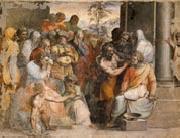 |
Perino Del Vaga
|
|
Italian Mannerist Painter, ca.1501-1547
Italian painter and draughtsman. He trained in Florence, first with Andrea de' Ceri and from the age of 11 with Ridolfo Ghirlandaio. According to Vasari, he practised drawing by copying Michelangelo's cartoon for the Battle of Cascina (destr.). For Pope Leo X's entry into Florence in November 1515 he painted an allegorical figure on one of the twelve triumphal arches. Soon after, an obscure Florentine painter called Vaga took Perino to Rome, where he became known as del Vaga. There he continued his drawing studies, copying from works of antiquity and Michelangelo's ceiling in the Sistine Chapel. On the recommendation of Giulio Romano and Giovanni Francesco Penni, he joined Raphael's workshop, where he learnt stuccowork and how to design grotesques, through assisting Giovanni da Udine in the Vatican Logge. Soon he was painting scenes from Raphael's designs, and five or six ceiling frescoes in the Logge, including the Story of Joshua and the Story of David, are generally accepted as his. |
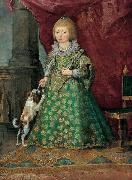 |
Peeter Danckers de Rij
|
|
Pieter, Peeter, or Peter Danckerts de Rij, Dankers de Ry, or Peteris Dankersas (1605, Amsterdam - 9 August 1661, Rudnik) was a Dutch Golden Age painter.
He was the son of Cornelis Danckerts de Ry, member of a large family of printers, painters and engravers.
Adam Kazanowski - by Peeter Danckers de Rij.
Example of Dankerts-Sandrart collaboration in print of PC Hooft. This 1642 engraving was painted by Sandrart, etched by Reinier van Persijn, and printed by Danckerts. The poem in Latin at the bottom was written by Caspar Barlaeus.Cornelis is mentioned in Houbraken's Schouburg as being one of the many teachers of Joachim von Sandrart in 1640-41, though considering Sandrart's age and experience (he had just returned to the North from his Grand Tour to Italy), this was more of a collaboration. Since Filippo Baldinucci later wrote a biograhical sketch on Pietro Danckerse de Ry in his list of artists called the Notizie, it is possible that Danckerts visited Italy at some time. In any case Sandrart engraved some of Peter's paintings after this period. Peter was active until 1640 in Amsterdam, and then he moved to Warsaw, Danzig, and Vilnius in the Polish-Lithuanian Commonwealth. He was active in Poland as the court painter and architect of the Polish King Władysław IV Vasa. According to Houbraken a poem was written in his honor that applauds his work in Poland. He died as the result of a highway robbery in the Redininkai Forest near Vilnius, Lithuania. |
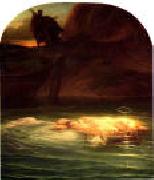 |
Paul Delaroche
|
|
1797-1856
French
Paul Delaroche Locations
Painter and sculptor, son of Gregoire-Hippolyte Delaroche. Though he was offered a post in the Bibliotheque Nationale by his uncle, Adrien-Jacques Joly, he was determined to become an artist. As his brother Jules-Hippolyte was then studying history painting with David, his father decided that Paul should take up landscape painting, and in 1816 he entered the Ecole des Beaux-Arts to study under Louis-Etienne Watelet (1780-1866). Having competed unsuccessfully for the Prix de Rome for landscape painting, he left Watelet studio in 1817 and worked for a time with Constant-Joseph Desbordes (1761-1827). In 1818 he entered the studio of Antoine-Jean Gros, where his fellow pupils included Richard Parkes Bonington, Eugene Lami and Camille Roqueplan. |
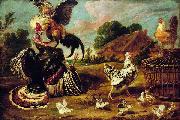 |
Paul de Vos
|
|
(1591e1592, or 1595, Hulst-30 June 1678, Antwerp) was a Flemish Baroque painter.
De Vos was born in Hulst near Antwerp, now in the Dutch province of Zeeland. Like his older brother Cornelis and younger brother Jan, he studied under the little-known painter David Remeeus (1559-1626). He specialized in monumental animal scenes, especially hunts for aristocratic patrons, that are heavily influenced by Frans Snyders (to whom his sister Margaretha was married). De Vos became a master and joined the guild of St. Luke in 1620.
As was frequent amongst artists in Antwerp, De Vos frequently collaborated with other painters. He painted animals in hunting scenes and armor in mythologies by Peter Paul Rubens and his studio. He also worked with Thomas Willeboirts Bosschaert, Erasmus Quellinus II, Anthony van Dyck, and Jan Wildens.
|
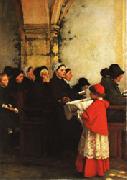 |
Pascal Dagnan-Bouveret
|
|
(January 7, 1852 - July 3, 1929), was one of the leading French artists of the academic school. He was born in Paris, the son of a tailor, and was raised by his grandfather after his father emigrated to Brazil. Later he added his grandfatheres name, Bouveret, to his own.
From 1869, he studied at the Ecole des Beaux-Arts under Alexandre Cabanel and Jean-Leon Gerôme. In 1873, he opened his own studio with a fellow student Gustave-Claude-Etienne Courtois. From 1875, he exhibited at the Salon, where in 1880 he won the first-class medal for the painting An Accident, and a medal of honour in 1885 for Horses at the Watering Trough.
From the 1880s, Dagnan-Bouveret along with Gustave Courtois, maintained a studio in Neuilly-sur-Seine, a fashionable suburb of Paris. By that time he was recognized as a leading modern artist known for his peasant scenes, but also for his mystical-religious compositions. His large-scale painting The Last Supper was exhibited at the Salon de Champ-de-Mars in 1896.[1] He also painted portraits for wealthy clients including the British collector George McCulloch. He was one of the first to use the then new medium of photography to bring greater realism to his paintings.
In 1891, he was made an Officer of the Legion of Honour; in 1900 he became a member of the Institut de France.
|
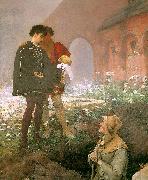 |
Pascal Adolphe Jean Dagnan-Bouveret
|
|
1852-1929
The popular French naturalist painter Pascal-Adolphe-Jean Dagnan-Bouveret is best known for his painstakingly detailed paintings of peasant scenes. Dagnan-Bouveret also created portraits and religious paintings.
Pascal-Adolphe-Jean Dagnan was born in Paris on Jan. 7, 1852. His father moved to Brazil when he was 16, but he decided to stay in France with his mothers father. Later Dagnan-Bouveret added his grandfathers family name Bouveret to his own. Dagnan-Bouveret entered art school in Paris at age 17 and studied under the well-known academic painter Gerome. During this period Dagnan-Bouveret entered his paintings in several official competitions and placed highly in several. In 1878 Dagnan-Bouveret moved to the region known as the Franche-Comte, where he produced many landscapes and still life paintings. Dagnan-Bouveret won recognition in 1880 with his oil painting An Accident, which depicts a peasant boy with an injured hand visiting the doctor. Considered one of his finest paintings, it exemplifies Dagnan-Bouverets attempt to examine the psychology of his subjects through the use of well-rendered detail.
Dagnan-Bouveret took advantage of new photographic technology to bring greater detail and heightened realism to his paintings. Dagnan-Bouveret used this technique especially in his paintings of peasants, such as Horses at the Watering Trough (1885). Dagnan-Bouveret was known to select people from his village, dress them in historical costumes, and then take photographs, which he then used with sketches as the basis of his paintings. By the 1890s his popularity as a portrait painter among wealthy patrons allowed him to explore more personal themes. Many of Dagnan-Bouverets later paintings, such as Supper at Emmaus (1896 C97), were religious in nature. Dagnan-Bouveret died in Quincey, Haute-Saone, France, on July 3, 1929. |
 |
Pablo de Cespedes
|
|
(1538 - July 26, 1608) was a Spanish painter, poet, and architect.
His father, Alonso Cespedes, was descended of a noble Castilian family, once settled at Ocaña, and the name of his mother, who was a native of Alcolea de Torote, was Olaya de Arroya. Pablo was born and brought up in the house of his father's maternal uncle, Francisco Lopez de Aponte, Canon of Cordoba, where he received a learned education. At the age of eighteen, in 1556, he was sent to the Universidad Complutense in Alcale de Henares, and there, devoted himself to the acquirement of Oriental languages and theology. He later moved to Rome where he studied painting under Federico Zuccari.
He was in Rome in February 1559, engaged in conducting certain negotiations for the Archbishop Carranza de Miranda, of Toledo, who then stood charged with heresy before the Inquisition of Valladolid. On the 17th of that month he addressed a letter to the prelate, informing him how his business stood at the Vatican, in which he incautiously reflected on the conduct of the Inquisitor-General Valdez, and the Holy Officeean offence which no Inquisitor-General would forgive. This document and others were seized with the primate's papers; he was therefore denounced by the tribunal, and but for his fortunate absence, would have been imprisoned. It is probable that he did not venture back into Spain for many years, until he had covered his sins with the protecting robes of the Church.
He remained in Italy for over 20 years and built a reputation as an artist. His only surviving works from that period are the frescoes he painted in the Bonfili chapel at the Santa Trinite dei Monti church in Rome.
He returned to Spain in 1577, and was appointed as the canon of the Cerdoba cathedral. He continued to write books on antiquarian topics such as the architecture of the temple of Solomon. He befriended Arias Montano. In 1604 he composed his Discourse of Ancient and Modern Painting and Sculpture in which he recounts anecdotes of Renaissance masters of Italy.
|
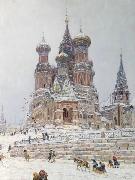 |
Nikolay Nikanorovich Dubovskoy
|
|
Russian, December 17, 1859 - February 28, 1918) was a Russian landscape painter.
He studied from 1877 to 1881 at the Imperial Academy of Arts in Saint Petersburg under Mikhail Konstantinovich Klodt. In 1886, he became a member of the Peredvizhniki (the Wanderers), a group of Russian painters. In 1900, he became a member of the Academy of Arts. |
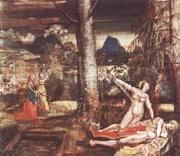 |
Niklaus Deutsch
|
|
1484-1530 Northern Renaissance German,Painter, draughtsman, designer, writer and politician. Some early designs in pen and wash |
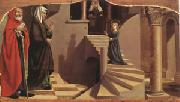 |
Nicolas Dipre
|
|
b Paris; fl 1495; d by 14 March 1532). French painter. Documents describe him as parisianus, and he appears to have belonged to a family of painters from Ypres or Amiens. His father, Nicolas Dipre the elder ( fl 1464, d before 1508), known as Colin d'Amiens, worked as a painter in Paris and was sufficiently well known in 1481 to be commissioned to produce a design for the tomb of Louis XI; his grandfather was probably the Andre d'Ypres documented in Amiens from 1435 to 1444. Nicolas Dipre is first referred to in 1495 in Avignon, where he worked for the rest of his life, gaining a widespread reputation. |
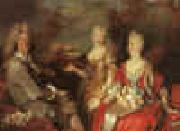 |
Nicolas de Largilliere
|
|
1656-1746
French
Nicolas de Largilliere Gallery
Nicolas de Largilli??re (October 10, 1656 - March 20, 1746), French painter, was born in Paris.
His father, a merchant, took him to Antwerp at the age of three. As a boy, he spent nearly two years in London. Sometime after his return to Antwerp, a failed attempt at business led him to the studio of Goubeau. However, Largilli??re left at the age of eighteen to seek his fortune in England, where he was befriended and employed by Lely, for four years at Windsor.
His skills attracted Charles II, who wished to retain him in his service, but the fury aroused by the Rye House Plot against Roman Catholics alarmed Largilli??re. He left for Paris where he was well received by Le Brun and Van der Meulen. Despite his Flemish training as a portrait-painter, his reputation was soon established. Largilli??re's brilliant colour and lively touch attracted celebrities of his day??actresses, public men and popular preachers flocked to his studio. President Lambert, with his beautiful wife and daughter, were among his most noted subjects. |
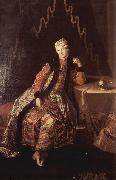 |
Nicolas de Largilliee
|
|
Largilliere's father, a merchant, took him to Antwerp at the age of three. As a boy, he spent nearly two years in London. Sometime after his return to Antwerp, a failed attempt at business led him to the studio of Goubeau. However, Largilliere left at the age of eighteen and went to England, where he was befriended and employed by Peter Lely for four years at Windsor, Berkshire.
Painting careerEarly careerHis painting caught the attention of Charles II, who wished to retain Largilliere in his service, but the controversy aroused by the Rye House Plot against Roman Catholics alarmed Largilliere. Largilliere left for Paris, where he was well-received by the public as a painter.
Upon ascending to the throne in 1685, James II requested Largilliere to return to England. James II offered Largilliere the office of keeper of the royal collections, but he declined due to being uneasy about Rye House Plot. However, during a short stay in London, he painted portraits of the king, the queen Mary of Modena, and the prince of Wales James Francis Edward Stuart. The portrait of the Prince of Wales could not have been painted during Largilliere's stay in London because the prince was not born until 1688. The three portraits painted by Largilliere of the prince in his youth must have been executed in Paris, where he returned sometime before March 1686. The portrait of King James II was painted in 1686. King James is portrayed in golden armor with a white cravat and is positioned in front of a watercolour-like background set in a round frame. |
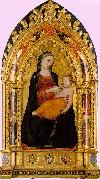 |
Niccolo di Pietro Gerini
|
|
Italian Painter, active ca.1368-1415
died in Florence in 1415, earned reputation of an important Italian painter. He represents giottesque school, in the tradition of the Andrea di Orcagna (1320-1368) and of Taddeo Gaddi. His father Pietro Geri is registered as a member of Lucas Guild in 1339. Niccolo worked mainly in Florence, although he also carried out commissions in Rome (Vatican), Pisa and Prato.
He was first recorded in 1368 as a member of the Arte dei Medici e Speziali in Florence but is identifiable with the Niccolo dipintore who collaborated with Jacopo di Cione on frescoes for the Guildhall of the Judges and Notaries in Florence in 1366. It is self-evident that he is the Niccolaio dipintore who worked with Jacopo di Cione on the altarpiece of the Coronation of the Virgin (presently in London, National Gallery) for St Pier Maggiore, Florence in 1370 and was paid 12 golden florins per disegnare la tavola dell altare in November of the same year. He designed the altarpiece and the elaborate throne canopy with his usual fine painting and detailed ornaments whilst Jacopo di Cione was depicting side saints. This altarpiece is amongst of very few largest commissioned in 14th century Florence. It was seemingly commissioned by Albizzi family.
He was collaborating with Jacopo di Cione on Coronation of the Virgin (Accademia, Florence) in 1372. Offner and Steinweg suggest that he was responsible for the design and fine painting and Jacopo for the execution of saints. It was commissioned by the mint of Florence Zecca Vecchia on the same year.
In 1383 Gerini again worked with Cione on a fresco of the Annunciation in the Palazzo dei Priori, Volterra. This fresco clearly shows the work of two very different artists: Niccolo di Pietro Gerini (design and very fine painting) and Jacopo di Cione (broadly painted saints and side decoration). In 1386 Niccolo frescoed the façade of the Bigallo, Florence. He also frescoed Sant Ambrogio church in Florence
Gerini performed the Crocefissione of St Felicita church in Florence.
His hand is clearly on sacrestia of the basilica of Saint Croce to Florence with Scenes of the life of Christ. Between 1391 and 1392 he worked in Prato where he frescoed Palazzo Datini, church of Saint Francisco with Lorenzo di Niccolo and Agnolo Gaddi.
He also frescoed capitolare of the church of Saint Francisco, Pisa.
Very typically for Gothic depiction Gerini figures have large chins, sloping foreheads, and sharp noses whilst their bodies are squat and frontally displaced.
Another important artist Lorenzo di Niccol?? di Martino was trained in Niccol?? di Pietro Gerini workshop and later collaborated with the master but was not his son as sometimes erroneously stated. Gerini though had a son Bindo di Niccolo di Pietro Gerini, born in 1363, who is registered as member of Lucas Guild since 1408.
Niccolo di Pietro Gerini works can be found in major art galleries of Rome, Vatican, Florence, London, Milan, New York, Los Angeles, Amsterdam, Berlin, Paris, St Petersburg, Boston, Cambridge, Budapest, Birmingham, Pegalo, Prato, Pisa, Altenburg, Avignon, Denver and several other museums. |
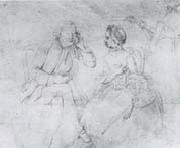 |
Nathaniel Dance
|
|
English Painter, 1735-1811,Painter and politician, elder son of George Dance . He trained under Francis Hayman before travelling to Rome in 1754. As Nathaniel Dance he established himself as a portrait painter but was determined to succeed as a history painter. His picture the Death of Virginia (1759; untraced, but known from a sketch, London, Soane Mus.) is of documentary importance as the first dated Classical history painting by a British artist working in Rome. In 1762 Dance assisted Pompeo Girolamo Batoni, whose influence brightened his palette and introduced him to a grander clientele, including Edward Augustus, Duke of York (1739-67), who sat for both artists in 1764 (Dance's Edward Augustus, Duke of York, London, Buckingham Pal., Royal Col.). In the same year Dance painted a portrait of Angelica Kauffman (Burghley House, Cambs), with whom he was in love. He returned to London in 1765 and rapidly achieved fame as a portrait and history painter. His Timon of Athens (1767; London, Buckingham Pal., Royal Col.) was purchased by George III; but after the King appointed Benjamin West to be his history painter in 1772, Dance concentrated on portraits. He was among the 22 artists who successfully petitioned the King in 1768 to establish a Royal Academy, and he served for periods as a council member and visitor, until 1782. At the Academy's first exhibition (1769) Dance showed full-length portraits of George III and Queen Charlotte (Uppark, W. Sussex, NT); two years later he exhibited David Garrick as Richard III (Stratford-on-Avon, Town Hall). In the mid-1770s Dance became financially independent, and his output declined sharply, virtually ceasing after his marriage in 1783 to a wealthy widow. He resigned from the Academy in 1790 on his election as Member of Parliament for East Grinstead and subsequently only exhibited occasional landscapes as a 'gentleman'. In 1800 he was created a baronet and assumed the name of Dance-Holland; he died worth over |
 |
Nardo di Cione
|
|
Italian Byzantine Style Painter, active 1343-ca.1365
was an Italian painter, sculptor and architect from Florence. He was the brother of the more accomplished Andrea di Cione, called Orcagna, as well as Jacopo di Cione; they were important members of the Painter's Guild of Florence. While Orcagna has been noted as the more accomplished artist, Nardo developed his own unique style, described as a pronounced lyrical vein, a feeling for poetic values, strong human sympathies and great sensitivity to colour as a means of subtle differentiation and soft modeling. The brothers collaborated on a number of works from their studio together, including the decorations from the Cappella Strozzi in the Santa Maria Novella. While Orcagna painted the altarpiece, Nardo executed the frescoes of The Last Judgment, Paradise and Hell. |
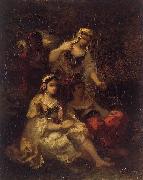 |
Narcisse Virgilio Diaz
|
|
August 25, 1807-November 18, 1876) was a French painter of the Barbizon school.
Diaz was born in Bordeaux to Spanish parents. At the age of ten, Diaz became an orphan, and misfortune dogged his early years. His foot was bitten by a reptile in Meudon wood, near Sevres, where he had been taken to live with some friends of his mother. The bite was poorly dressed, and ultimately he lost his leg. However, as it turned out, the wooden stump that replaced his leg became famous.
At fifteen he entered the studios at Sevres, first working in the decoration of porcelain occupied him and later turning to painting. Turkish and Oriental scenes attracted him, and he took to painting Eastern figures dressed in richly coloured garments; many of these paintings remain extant. He also spent much time at Barbizon.
At Fontainebleau Diaz found Rousseau painting his wonderful forest pictures, and was determined to paint in the same way if possible. However, Rousseau was then in poor health, embittered against the world, and consequently was difficult to approach. On one occasion, Diaz followed him surreptitiously to the forest, wooden leg not hindering, and he dodged round after the painter, trying to observe his method of work. After a time Diaz found a way to become friendly with Rousseau, and revealed his eagerness to understand the latter's techniques. Rousseau was touched with the passionate words of admiration, and finally taught Diaz all he knew.
Diaz exhibited many pictures at the Paris Salon, and was decorated in 1851. During the Franco-German War he went to Brussels. After 1871, his works became fashionable and rose gradually in the estimation of collectors, and he worked constantly and successfully. Diaz's finest pictures are his forest scenes and storms, and it is on these that his fame rests. There are several examples of his work in the Louvre, and three small figure pictures in the Wallace Collection, Hertford House. |
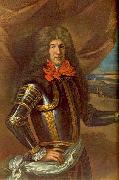 |
Musee national de la Marine
|
|
(National Navy Museum) is a maritime museum located in the Palais de Chaillot, Trocadero, in the XVIe arrondissement of Paris. It has annexes at Brest, Port-Louis, Rochefort (Musee National de la Marine de Rochefort), Toulon and Saint-Tropez. The permanent collection originates in a collection that dates back to Louis XV of France.
In 1748, Henri-Louis Duhamel du Monceau offered a collection of models of ships and naval installations to Louis XV of France, with the request that the items be displayed at the Louvre and made available to students of the Naval engineers school, which Duhamel headed. The collection was put on display in 1752, in a room of the first floor, next to the Academy of Sciences; the room was called "Salle de Marine" (Navy room), and was used for teaching.
With the French Revolution, the Salle de Marine closed in 1793. The collection was added to models owned by the King personally, to others owned by the Ministry of Navy, and yet others owned by emigres or executees (notably Philippe Égalite). A short-lived museum was opened between 1801 and 1803 at the Ministry of Navy, then located at Place de la Concorde.
|
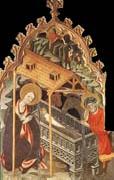 |
MUR, Ramon de
|
|
Catalan painter
active in first half of 14th century in Tarragona |
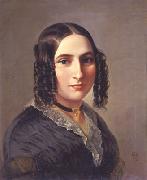 |
Moritz Daniel Oppenheim
|
|
(January 7, 1800, Hanau, Germany - February 26, 1882, Frankfurt am Main) was a German painter who is often regarded as the first Jewish painter of the modern era. His work was informed by his cultural and religious roots at a time when many of his German Jewish contemporaries chose to convert. Oppenheim is considered by the scholar Ismar Schorsch to be in sympathy with the ideals of the Wissenschaft des Judentums movement, because he remained "fair to the present" without denying his past.
Oppenheim was born to Orthodox Jewish parents at Hanau, Germany in 1800; he died at Frankfurt am Main in 1882. His niece was the wife of student and fellow painter Benjamin Prins, Rosa Benari.
He received his first lessons in painting from Westermayer, in Hanau, and entered the Munich Academy of Arts at the age of seventeen. Later he visited Paris, where Jean-Baptiste Regnault became his teacher, and then went to Rome, where he studied with Bertel Thorwaldsen, Barthold Georg Niebuhr, and Friedrich Overbeck. There he studied the life of the Jewish ghetto and made sketches of the various phases of its domestic and religious life, in preparation for several large canvases which he painted upon his return to Germany. In 1825 he settled at Frankfurt, and shortly after exhibited his painting David Playing Before Saul, to see which a great number of admirers from all parts of Europe visited his studio. In 1832, at the instance of Goethe, Charles Frederick, Grand Duke of Saxe-Weimar-Eisenach conferred upon him the honorary title of professor.
|
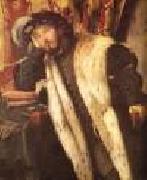 |
MORETTO da Brescia
|
|
Italian High Renaissance Painter, 1498-1554
Italian painter. Together with Romanino and Giovanni Girolamo Savoldo, he was one of the most distinguished painters of Brescia of the 16th century. Influenced by both Lombard verism and contemporary Venetian painters, Moretto created an individual style in which realism and Venetian light and colour were perfectly balanced. He was personally involved in the local movement of Roman Catholic reform, and this is reflected in his direct, solemn and often moving depictions of religious subjects. |
 |
Michele da Verona
|
|
(Michele di Zenone) (born 1470) was an Italian painter of the Renaissance period.
He was born in Verona, a contemporary of Paolo Morando(Cavazzola), and may have assisted him in the decorative work for San Bernardino there. Inside the portal of San Stefano, Milan, is a large Crucifixion signed by him in 1500, and formerly in the Refectory of San Giorgio, of Verona. The same subject, dated by him in 1505, is in Santa Maria in Vanzo, Padua. In both pictures there is an imitation of the manner of Jacopo Bellini. In the church of Santa Chiara, Verona, are frescoes representing the Eternal, with Angels, Prophets, and the four Evangelists, dated 1509. Frescoes of later dates exist in the churches of Vittoria Nuova and Sant' Anastasia; while in the church of Villa di Villa, near Este, is a Madonna and Child, between SS. John the Baptist, Lawrence, Andrew, and Peter dated 1523.
|
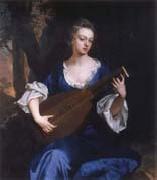 |
Michael Dahl
|
|
Swedish Baroque Era Painter, 1659-1743,Swedish painter, active in England. He studied under Martin Hannibal (d 1741) and later with David Kl?cker Ehrenstrahl. In 1682 he travelled to London, where he became acquainted with Godfrey Kneller and Henry Tilson, and in 1685 he left for Europe with the latter, working briefly in Paris before proceeding to Venice and Rome, where they stayed for about two years. In Rome Dahl converted to Roman Catholicism and gravitated towards the circle of Christina, former Queen of Sweden, who sat for him (Grimsthorpe Castle, Lincs). He returned to England with Tilson via Frankfurt and arrived in London in 1689; he stayed in England for the remainder of his career. |
|

